Definitions: Tone, harmonic, ratio.
A tone f is a positive real number with units of Hz (the frequency of the tone).
A harmonic h is a positive integer.
A ratio r is a positive rational number.
We can then use the first two of these to define a harmonic of a tone and a tonic of a tone.
If f1 and f2 are tones, h is some harmonic, and if
then f2 is said to be a harmonic of f1, and f1 is said to be a tonic of f2.
The word harmonic, as used in this definition, is practically equivalent to the use of the word in physics. The word tonic is not really used in the same way as it is in standard music theory; it actually is, at this point, practically equivalent to the notion of the fundamental tone or fundamental frequency in physics.
I use these words to try and connect them with the concepts of harmony and tonality. I don't want to actually give a solid definition of these terms, as they are still somewhat vague to me. But essentially, these ideas are based in the concept that what is actually physically heard in music are harmonics of tonics; thus, harmony in a sense represents the "instantaneous" or present quality in music, the harmonics or tones that are being perceived. The tonics are not necessarily heard as such, but are implied through an infinite variety of subtle little tricks, and often these tricks play out over significant periods of time; the way in which this happens, and the tones involved, comprise the tonality. What are the tonics I am hearing? What are the harmonics of those tonics that I am hearing? Tonal music achieves many of its great effects through the tension and ambiguity (or lack thereof, for boring music) it introduces by playing with one's perceptions of the heard and the unheard, so to speak. It attempts to, in a sense, confuse the listener into expecting to hear any of a variety of different things, based on inferences in the music, and then guiding the listener through one particular possible exposition of these inferences, whether surprising, satisfying, or disappointing the listener. It's a fun little game to play.
I also shy away from giving definitions of harmony and tonality because I also think that they are really two words which attempt to describe opposite ends of a kind of spectrum, and that really there is a continuum which exists between them. This should be clear enough to anyone who has studied harmony and tonality, as tonalities can often be ambiguous, be multi-leveled, be themselves based upon harmonies, etc. The definitions I have given above for harmonics and tonics I think are much more useful for the present discussion, and through them I think that the concept of the continuum should become more and more apparent.
I will, however, continue to use these terms from time to time, and by using them I really just mean in a sort of abstract way "the issue of harmonics and tonics."
I don't actually want to give any definitions of consonance and dissonance, I just want to briefly mention these concepts. There have been scores of attempts to devise good measures of consonance, and probably all of them make sense in one form or another. But since there are so many different ways of measuring something which seems to have to do with the perceptual concept of consonance, it seems useless to me to even assume that such an all-encompassing measure exists. So instead of going that route, I would much rather dispense with these terms entirely and merely present different ways of measuring different things, giving them their own names which describe accurately what they are, rather than trying to classify them under vague umbrella terms like consonance and dissonance. That means that a full understanding of the perceptual quality of what is measured by these methods cannot be obtained without actually listening to different combinations of tones and comparing their qualities with the measures.
The harmonic overlap function I think is a very basic but useful approach to quantifying a rather simple property of tone combinations. It basically tries to answer the question, "If I sound two tones, how much of their harmonic series overlap?"
Let us now define a function which in a sense simulates the effect of hearing the harmonic series of a "typical" (or maybe idealized) musical sound. First of all, practically all tonal instruments have harmonic series in which the amplitude of each harmonic decays with increasing harmonic number. Furthermore, our hearing does have a finite precision, and so in a sense when a tone is heard, our perceptual mechanism cannot precisely distinguish it from other very nearby tones. Then let us define a function which, for each harmonic, defines a sort of probability of the perceived frequency, as a Gaussian function (a more or less arbitrary choice);
Let us then define the harmonic weighting function for the amplitude of each harmonic as an exponential function (again essentially arbitrarily);
We then weight the probability function by the harmonic weighting function via multiplication in order to obtain the full function for each harmonic;
To then obtain a function which describes the harmonic series, we sum this function over all harmonics;
The first 9 harmonics of this function are plotted here:
This actually doesn't look too different from a Fourier transform of a basic musical tone. Theoretically I suppose one could define different functions for timbres of different instruments, but that is beyond the scope of this work. This function is intended to be interpreted in a most general way.
Say then that we have another tone which is a ratio r away from the original tone;
We can then plot S ( f0 ) and S ( f1 ) simultaneously to visualize how much of the series overlap (in this graph, for r = 3/2, where S ( f0 ) is in blue and S ( f1 ) is in red);
Mathematically speaking, to obtain a new function which expresses the amount of overlap as a function of frequency, we may multiply the two series functions together. For r = 3/2, we obtain
Then, to obtain a function which describes the total amount of overlap over the entire harmonic series, we integrate the product of the two series functions over all frequencies (i.e., finding all of the area under the curves in e.g. the above two plots). Then a harmonic overlap function can be defined as
Let us now remove the restriction that the two tones must be related through a rational number, and replace r by a positive real number q, so that
Now we will make a substitution for the integration variable;
By making this substitution in the above integral, we find first that there is an additional factor of f0 which gets absorbed into the normalization constant. Furthermore, we can then factor an f02 out of the first two factors of the exponent; we will now absorb that factor into kP. By then using the relationship between q, f0, and f1, we can then rewrite as a function of q alone;
Taking the limits of the integral to be +/- infinity (which is more or less justified, since the Gaussian functions "technically" extend to both infinities), we can then integrate the sum term by term to obtain
This function is plotted below, with kP = 750, kW = 1/50, with the sums running up to the 128th harmonic, and with the ratios of a basic just major scale marked on the horizontal axis;
Now, let us ignore for a moment whatever validity the use of the Gaussian function has, and whatever meaning the "perceptual spread" of frequencies has; let us idealize this situation slightly, and look at the limit of this function as kP goes to infinity. Then the Gaussian function turns into a unit impulse function;
Obviously, the only terms of the sums which will be nonzero are those terms for which
Evaluation of the sum leads to
And finally, to simplify further, allowing kW to tend towards zero - i.e., allowing the harmonic amplitude to fall off in intensity "just slow enough" to allow the integral to converge, we can then take the first two terms in the expansion of the exponential function and allow kW to be absorbed into the normalization constant to give us a particularly simple form of the overlap function;
Plotting this function is actually somewhat less computationally convenient, since one has to generate a sequence of rational numbers and plot each one individually, rather than merely plugging a sequence of equally spaced q values into a simple formula. To generate this plot, then, a Farey sequence with integers up to 128 is generated, and from this, the overlap function is calculated;
This graph shows a number of interesting properties. The areas in between each large peak appear to be slightly skewed copies of the entire graph, in a sort of fractal-like manner. There is also a simple relationship between the form of the rational numbers and the locations of the larger peaks. Taking, for example, the region between 9/8 and 5/4, the large peaks occur at 8/7, 7/6, and 6/5; these are known in older terminology as "superparticular ratios," meaning that the numerator is one greater than the denominator; i.e., ratios of the form (k + 1) / k, or 1 + 1 / k. This is true for all of the larger peaks on the left side of the graph (for ratios less than 3/2). On the right side, for q > 3/2, the large peaks occur at, in a sense, ratios which are "complementary" to the superparticular ratios, i.e., ratios of the form 2 - 1 / k.
Clearly this function has at least something to do with the notion of consonance, since all of the intervals in the major scale generally considered as consonant have a large degree of harmonic overlap. But obviously, this only gives part of the story. For example, 9/8 and 15/8 are generally considered to be not particularly consonant, yet they do appear in the major scale, and indeed are vitally important to it. Why are these tones so important, if they are not particularly "consonant" with respect to 1/1? The answer, of course, lies in the interplay between harmony and tonality, the subject of the next section. But before proceeding, I would like to discuss the possibility of a "multidimensional" overlap function.
If we consider not a combination of two tones, but of three, then we can investigate the harmonic overlaps of triads. It should be pretty clear proceeding from the above discussion that this function would take the form
Integration gives
where
plots...
To give a limiting form similar to with the dyadic function, we can note that in the above integral, replacing the Gaussian function with a product of three impulse functions and integrating gives a sum
where the summation indices satisfy
Substituting, we see that in order that the equations
be satisfied, we need to have that
for some integers i, j. From the first equation, we see that
where the right hand side must be an integer, since i is an integer. Then we must have
We can then factor out the GCD to yield
And since the reduced factors are now relatively prime, we have
or
for any integer c. Using appropriate substitutions in the above equations, we then find that
The overlap function then takes the form
where the index c runs through the integers. As before, evaluation of the sum yields
Taking the limit of the exponential function, we obtain finally
This function is plotted below with a logarithmic coloring scheme (brighter means greater overlap):
We may now consider an alternate version of this function. Instead of asking the question "how many harmonics of these tones overlap," we may ask "how many tonics of these tones overlap?" In other words, we may calculate something which tells us how many tones that all the tones in the triad occur as harmonics of. Mathematically speaking we are then trying to find the "subharmonic" overlap; that is, not integer multiples of the fundamental frequency, but integer divisions of it. This leads to replacing the h's in the Gaussian functions with 1/h's, or equivalently, to doing the same in the relations which define the summation indices in the limiting version of the function. But, upon inverting these relations, we find that this is the same as replacing the q's with 1/q's, which is then the same as swapping the numerators and denominators (the n's and m's). We may then write the tonic overlap function as
This function is plotted similarly below:
Let us now, for the following discussion, temporarily forget about the notion of harmonic overlap between two harmonic series, or even that a tone should have a harmonic series, and try to focus more on the relationships which exist between single tones. Recall the relationship between a harmonic and a tonic; a harmonic is an integer multiple of a tonic. Then if we have a given set of tones, we might be able to say something about which ones could possibly be harmonics of other tones in the set, and which ones could be tonics of other tones in the set.
To make this process a bit more transparent, and perhaps to keep with tradition in a certain sense, the concept of octave equivalence needs to be addressed. This concept has a great deal of historical and perceptual precedence; it is the reason why we call an A an A, regardless of what octave you are playing it in, i.e. it is the reason there are eight A's on a piano keyboard. It is clear enough from a musician's point of view that there is something quite fundamentally common to each and every A, even though the effect achieved is quite a bit different from one octave to another. In a certain sense, however, we can describe the differences which do exist between the A's as being a difference in texture, not necessarily tonality or harmony. Concepts of tonality are practically devoid of any sense of there being different octaves; that is why we say a piece is in the key of C, not any particular C. Harmony is a bit different in this regard since its expression is of the more immediate sort, and so is more closely linked to texture. One might say that chords which involve the same "lettered" notes, but with different permutations of the octaves, are different harmonies in a certain sense, but they would all be described using the same chord names; a C minor chord is a C minor chord, even though there are plenty different ways of spreading out the notes involved in a C minor chord throughout any number of octaves. In this work, an approach is taken where essentially differences in octaves are ascribed to texture, and the analysis of harmony and tonality excludes the meaning inherent in using different octaves.
Mathematically speaking, differences in octaves involve multiplication of frequencies or ratios by factors of 2. In order to implement the notion of octave equivalence mathematically, then, we simply omit all factors of 2 from the notation. This greatly simplifies the notation. It will also become more and more apparent that factorization of integers into prime numbers plays a very fundamental role in tonality and harmony.
The importance of prime numbers is essentially because of the fact that they cannot be factored any further. The reason this is musically important is that tonal and harmonic relationships are often forged through the process of building new ratios upon existing ratios through the process of multiplication. Ambiguity in tonality and harmony tends to result when there are many potential ways by which a given ratio could be arrived at through a series of multiplications. But relationships which involve a single prime number cannot be ambiguous, because there is only one way in which they can occur. A 3 is only a 3, but a 15 can be either a 15, a 3 and then a 5, or a 5 and then a 3. Order is important because tonal relationships in particular are often built up over time, and so it makes sense to distinguish, in a tonal situation, between 15, 3*5, and 5*3, because we previously may have spent some time exploring harmonies built upon 5 or 3 before we end up building harmonies on 15, or we may have not spent any time on 3 or 5 and jumped immediately to 15.
To explore some of these concepts, let us first give an alternative form of the relationship between a harmonic and a tonic;
For the following discussion we can then assume octave equivalence. So when we write a ratio, all factors of 2 will be omitted, and when we speak of a tone as being a harmonic or a tonic, it will be assumed that octave equivalent harmonics or tonics are being described. Notationally, we will also write all ratios in the form of their prime factorizations.
So, for example, let's start out with a just major chord. The ratios in a major chord are 1/1, 5/4, and 3/2. Removing the factors of 2 gives simply 1, 5, and 3. We can then define a set of ratios representing an octave equivalent major chord as
To unravel the tonal and harmonic relationships which exist in this set, we want to see how many of the tones can be factored in the form
We can then see that there are only two ways we can make such factorizations in R;
Then 5 and 3 are both once implied as harmonics, and 1 is twice implied as a tonic. This is very much in accordance with the experience of hearing a major chord; there is really very little ambiguity in which tone "gives rise" to the others, or which tone serves as the "root" tone.
Suppose we were to then try and quantify the degree of "tonicness" and "harmonicness." It is pretty clear, both mathematically and perceptually, that there is a simpler relationship between 1 and 3 than there is between 1 and 5. It is more difficult for the auditory mechanism to perceive a clear relationship between larger harmonics than smaller ones. In this case, both 3 and 5 are perceived as being clearly quite consonant, so it is hard to tell a really big difference; but a larger prime, such as 11, is much more vague. Again, only audio experiments can really explain this concept well.
Then we would need again some kind of weighting function to describe how closely two tones are related. Using the above notation, if f2 is the h'th harmonic of f1, then we can say that f2 is a harmonic of f1 to an extent of 1/h, or that f1 is a tonic of f2 to an extent of 1/h. The choice of the function 1/h is essentially arbitrary, though one could probably find some reason for justifying its use.
We can then combine all of the extents of each factorization through addition. So then, in this example, since 1 is implied as a tonic to an extent of 1/5 in one factorization, and 1/3 in the other, then in all it is implied as a tonic to an extent of 1/5 + 1/3 = 8/15. In this way, we can then calculate the extents of "tonicness" and "harmonicness" for each tone in the set;
Let's add a bit more complexity by including another tone in our set, the just major second, or 9/8; applying octave equivalence and prime factorization gives the representation 32. Our tone set becomes
Let us now list the tonic/harmonic factorizations of this set:
Now, 1 is implied three times as a tonic, but 3 is implied once. Then one can say that in this tone set, 3 plays a minor role as a tonic. Musically the relationship between the major second and the perfect fifth is easily perceived. We can then again calculate the extents of tonality and harmony;
Something sort of interesting happens when we include the perfect fourth in our set, which is 4/3, or 3-1. We have then
The interesting thing to note here is that 3-1 can be written as the tonic of any other tone in the set, but cannot be written as the harmonic of any other tone in the set; this makes it "more of a tonic" than 1. This has to do with the fact that it is the only tone in the set with a negative exponent, and has no factors with positive exponents. This means that any ratio with a positive exponent can be obtained from it, since 3 * 3-1 = 1, from which any other integer can be obtained; and since there are no other tones with negative exponents, multiplying another tone by an integer to obtain 3-1 is impossible, since an integer always has a positive exponent.
Calculations then give
Let's move now to a more intricate and perhaps practical example, that of the just major scale. In this notational system, we have
The factorizations of this set are
We can then plot these data; for T, we have
and for H,
I will have more to say about these graphs in a moment, but first let me discuss a bit more about these factorizations and the tonal/harmonic extent sets.
It is difficult to obtain fully explicit formulae which can calculate the tonal and harmonic extent sets. Still one would like to have at least an algorithm which can perform such a calculation. In this effort, let us first note that in this tone set, as with many, the only prime factors present are 3 and 5. Instead of notating these factors explicitly, let us only keep track of the powers on 3 and 5. We can then adopt the notation (a,b) to represent the number 3a * 5b. Using this notation, the factorizations of the major scale can be written as
Clearly, the operation of multiplication represents an addition of exponents, so that (a,b) * (c,d) = (a+c,b+d). What is really going on here in the construction of such a table of factorizations as this is that we are trying to see if we can write one tone in the set as a number with nonnegative exponents (an integer) times another tone in the set.
Specifically, we can state something like the following.
Given a ratio set R, with r1 = (a,b), r2 = (c,d), and r1, r2 ∈ R, then the factorization
Using this idea, we can then propose an algorithm to calculate the tonal and harmonic extent sets.
Letting Tk represent the k'th element of the tonal extent set, Hm represent the m'th element of the harmonic extent set, and given a ratio set
Alternatively, we can write
In C, we have
When one creates an arbitrarily large set of tones, such as a Farey set, calculates these functions, and plots against frequency, the resultant graphs are not particularly illuminating. (graphs forthcoming)
Noting that the main influence in the extent functions is essentially the number of prime factors required to obtain one tone from another suggests that another form of defining our coordinates may provide a more meaningful picture of the relationships described by these functions. At this point we may use a concept which is fairly widespread among just intonation theories. This is the use of plots of the exponents on the prime factors involved in the tone sets.
For a set involving only factors of 3 and 5, we may allow the horizontal coordinate to represent the exponent on the 3, and the vertical to represent the exponent on the 5. This is equivalent to, using the notation above to represent a ratio r = 3a * 5b as (a,b), plotting the pair (a,b) as an x,y pair in a rectangular coordinate system.
We may obtain an explicit formula for the tonal/harmonic extent functions for a specific limiting case in which we take a tone set which fills a square in (a,b) space. Let us define a tone set which is indexed by the values of a and b, with a maximum magnitude of each power r ;
We may write the tonal extent function as
The third and fourth conditions imply that i ≥ a and j ≥ b ; the first and second imply that i ≥ -r and j ≥ -r. We already know by the definition of Rab that | a | ≤ r and | b | ≤ r ; this implies that a ≥ -r and b ≥ -r. We can combine these inequalities to state that i ≥ a ≥ -r and j ≥ b ≥ -r. This in turn implies that the inequalities i ≥ a and j ≥ b are sufficient to imply the conditions that i ≥ -r and j ≥ -r. Therefore we may write the summation indices as a ≤ i ≤ r and b ≤ j ≤ r. To take care of the fifth condition, we note that there is only one term in the double summation which is capable of satisfying both a = i and b = j simultaneously (i.e. there is only one tone in the set which is itself); the value of this term is, of course, 3050 = 1, and so we may simply subtract 1 from the total to enforce this condition.
We now note that the above sum can be written in the form
Using this, we may evaluate the sums in the tonal extent function to yield
Performing some simplifications, we may finally write this in the form
Using the same logic, we may write for the harmonic extent function
and H:
These graphs, as random as they might appear at first, are actually quite interesting to think about if you are familiar with playing music in a major scale. Again we see that the perfect fourth is the most "tonic" in the scale, followed closely by the unison. The fifth is next up, because a 1-5-3 major chord can be built upon it, but it is lower than the unison, because it lacks the 9th and 15th harmonics. The major sixth is next, since it has both a fifth and a ninth, followed by the major third, since it has a fifth. Neither the major seventh nor the major second have any tonal component. This actually brings up a very interesting issue, which is closely related to the whole reason equal temperament became so popular in the first place.
If you are used to playing the major scale, you are probably familiar with the fact that many pieces of music may have sections which are in the minor key of the major second. Let's use some equal temperament terminology and say that our major scale starts on C. Then we may have a D minor chord, built of D, F, and A. This is not unusual in tonal music. Clearly, D functions as the tonic when we are playing around in D minor. But, with this justly tuned scale, we cannot actually build a D minor chord, mainly because the A in this scale is a significant ways away from the "true" fifth of D; that is, 3/2*9/8 does not exist in this scale. The minor third, F, is also not the same as is found in the other, more consonant minor triads, those on E and A (which are both 1/1, 6/5, 3/2).
The reason for this is tonal. We have to ask the question of how we "got to" D from C. Did we get there by moving up by 9 from 1, did we get there by moving from 3 to 3*3, or did we get there by moving down 3 from 5/3? That is, did we modulate from C to D in the sense of the 9th harmonic, or from C to G to D in a cycle of fifths, did we modulate from C to A, then down a fifth from A to D, or did we modulate from C to F, then by a major sixth to D? That is, to use the form tone = harmonic * tonic again, we can write
To use more numerical notation to clarify the conflict here, we have
There are two different D's; they are 9/8 and 10/9. Numerically these values are fairly close, yet their difference in this scale is readily apparent. If we simply include 10/9 in the scale, then we find that we can use this tone as a tonic to create consonant (1/1, 6/5, 3/2) minor chords, but it can't be used, for example, in creating major chords based on the fifth, or creating harmonic 9th chords on the unison. It is the D which is 9/8 which is the "true" fifth of G, or ninth of C, but it is the 10/9 which is the true fourth of A, or major sixth of F. The two D's fulfill different roles in the scale; 9/8 can occur as a harmonic in two ways, but not as a tonic, whereas if 10/9 were in our scale, it could not function as a harmonic, but it would be a tonic of 5/3 (because 5 * 3-1 = 3 * (5 * 3-2)). Or, instead of adding 10/9 to the scale, say that we do want to modulate through a cycle of fifths, and we want to create a just minor chord on the D which is the fifth of G. The two other tones necessary for this chord are not in the scale; they are 33 * 5-1 and 33, or 27/20 and 27/16, though again, both 4/3 and 27/20 are F's, and both 5/3 and 27/16 are A's. Thus, if we include 10/9 in the scale, 9/8 functions solely harmonically, and 10/9 functions solely tonically. Equal temperament attempts to solve these kinds of problems, or hide these ambiguities, by making one D which can function approximately as either of these D's (or presumably even more complicated D's as well). One also has to consider at what point can our ears no longer easily distinguish between two nearby ratios which have significantly different harmonic and tonic roles in the scale, creating perceptual ambiguity; one then has to rely on inference in order to get a sense of how the tone is functioning in the music.
The issue of the minor chord itself is one of interest as well, which only leads into further issues with all other chords, including the major chord. We can spell the major chord as 1,5,3; two of the tones are unambiguously harmonics of 1, and 1 is unambiguously a tonic of the others.
Yet with the minor chord, the spelling that we get from, say, basing a minor chord on E or A in the just major scale, is 1,3*5-1,3. The second tone is clearly not a harmonic of 1; it is a harmonic of 5-1. Here we have an "implication" of a tonic which is not in the chord; in this case, 5-1. This is the simplest ratio (the one with the fewest factors) of which all the tones in the chord can be spelled as a harmonic; if we treat 5-1 as the tonic, then the harmonics spelling the minor chord are 5,3,15. So, for example, a minor chord on E in the just major scale implies C as tonic, and a minor chord on A implies F as tonic.
But if we can spell the minor chord as harmonics of a tonic, we might notice that even a major chord can be spelled as the harmonics of a tonic other than 1. As the simplest example, consider treating 3-1 as the tonic of a major chord; then we can spell the major chord as the 3,15,9 harmonics of 3-1. We then have that the major chord based on 1 implies not only 1 as the tonic, but 3-1 as well, although to a lesser extent, since the numbers of the harmonics are larger when treating 3-1 as the tonic. It even implies 5-1 as the tonic, just as the minor chord did, because it can be spelled as the 5,25,15 harmonics of 5-1, although again, to an even lesser extent, since these harmonic numbers are even greater. Thus, triads, which can be considered simple "harmonies," are harmonies of tonics to certain extents, just as harmonics are. Let me introduce some further notation to continue this discussion about triads and harmonies.
Given an ordered ratio set
we can define a selector operator of the form
such that
In case any of the s's are greater than n, we can let
We can now define the triad operator,
The rotation operator, which can operate on either tone sets or selector operators, can be defined through
and
So, for example, τnRM gives the triads in the major scale; e.g.,
We can also obtain other scales or modes through the rotation operator, e.g.;
Let us now try to write tonal/harmonic factorizations of these triads, but instead of using single tones and harmonics, we will use sets. So for τ1RM, we have
Things get a little more interesting when we introduce the possibility that a tonic can itself be a composition of multiple tonics. In standard music terminology, this is roughly equivalent to, say, modulating from I to V, then to vi/V, or something like that. Let us consider a simple tone set representing the "major seven" chord;
Let us now look at just the factorizations of 3*5, but this time, we will include only factorizations which allow for more than two factors on the right hand side;
Definition: Tonics and harmonics of tones.
Consonance and dissonance; the harmonic overlap function.
where f0 is the fundamental frequency (or tonic).
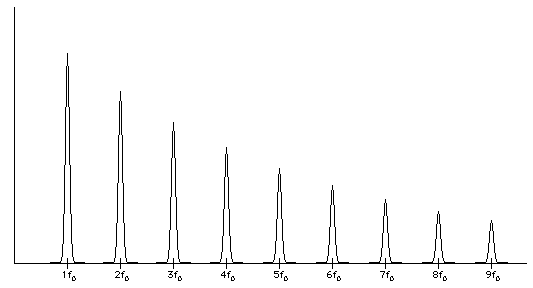
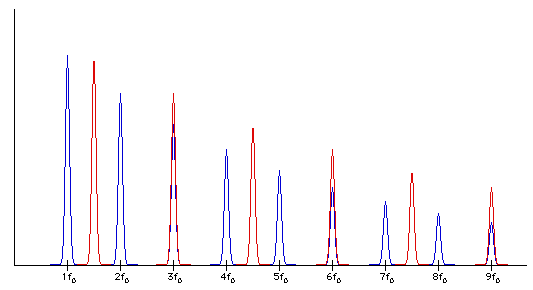
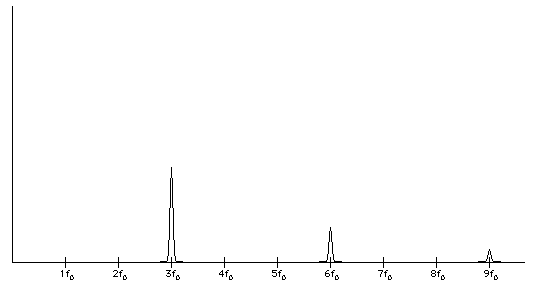
and, e.g., for r = 4/3,
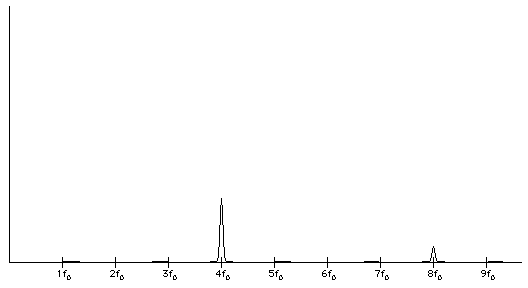
where K is an arbitrary normalization factor. We can then convert the product of two sums to a double sum of a product:

and since h0 and h1 are both integers, then the function will be zero whenever q is irrational. Then we can now focus on the case where q is rational, and write it in lowest terms as
for integers n and m. Then the equality q = h0 / h1 will be satisfied whenever
for integer i. Using this fact, we can dispense with all the terms in the double sum which do not satisfy these equalities, and replace h0 and h1 by the above to obtain
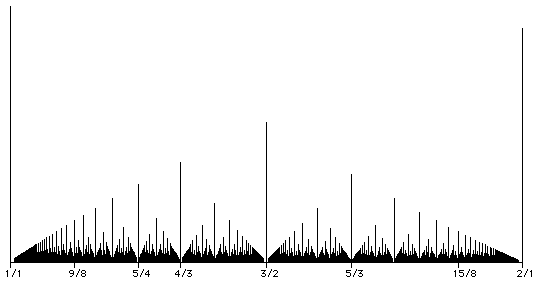

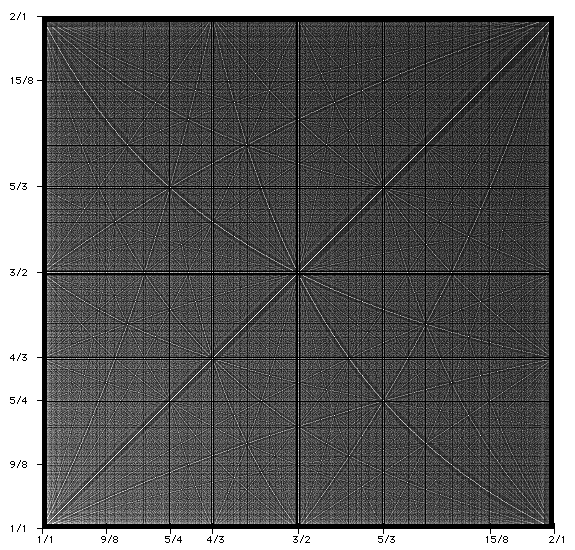
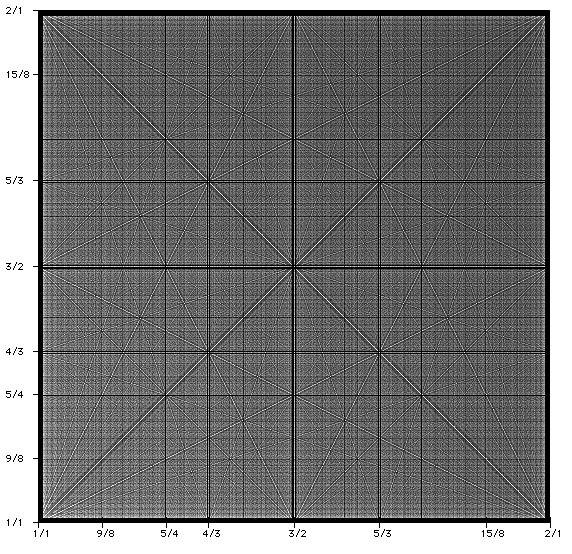
An initial foray into the realm of tonic/harmonic relationships; "harmonicless" tones, octave equivalence, and prime numbers.
where n is some integer. We can then say that f2 is an octave equivalent harmonic of f1, or equivalently, that f1 is an octave equivalent tonic of f2.
where the tone and the tonic are both in the set. We will also exclude the cases where the harmonic is equal to 1, since that merely represents a statement of the tonic itself.
with the factorizations
which leads to

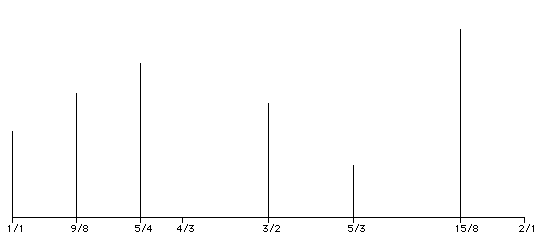
Definition; tonal/harmonic factorizations.
is a tonal/harmonic factorization with respect to the set R if and only if h is an integer; in other words,
is such a factorization iff a - c ≥ 0 and b - d ≥ 0.
Algorithm; calculating the tonal and harmonic extents.
We can then find all factorizations of the form
for all m, k ≤ n such that m ≠ k, ak - am ≤ 0, and bk - bm ≤ 0. The extent functions can then be calculated as
where the summation index m satisfies 1 ≤ m ≤ n, m ≠ k, ak - am ≤ 0, and bk - bm ≤ 0. Also,
where the summation index k satisfies 1 ≤ k ≤ n, m ≠ k, ak - am ≤ 0, and bk - bm ≤ 0.
where the δ's are unit impulse functions, and the summation indices k and m run through 1 ≤ k ≤ n and 1 ≤ m ≤ n.
for(k=0;k<n;k++) {
for(m=0;m<n;m++) {
h1=a[k]-a[m];
h2=b[k]-b[m];
if(m!=k && h1<=0 && h2<=0) {
T[k]+=pow(3,h1)*pow(5,h2);
H[m]+=pow(3,h1)*pow(5,h2);
}
}
}
where the summation indices i, j satisfy | i | ≤ r, | j | ≤ r, a - i ≤ 0, b - j ≤ 0, and (a - i ≠ 0 & b - j ≠ 0).
with the summation indices as defined above, and we can write the general form of the geometric series spanning index k from x to y as
where now | i | ≤ r, | j | ≤ r, i - a ≤ 0, j - b ≤ 0, and (a - i ≠ 0 & b - j ≠ 0). This leads to summation indices -r ≤ i ≤ a and -r ≤ j ≤ b. Writing
and using the general form
we see that
and finally
Harmonies; tonic/harmonic ambiguities; "implied" tonics.
Let me restate the graphs from above of the tonal and harmonic extent sets for the just major scale. Here's T:


Definitions; selector operator, triad operator, rotation operator.
where Rm is the just minor scale. Or we can obtain other triads with the rotation operator, since
so that, for example, ρ5τ1RM indicates a shift from the major triad on the tonic to that on the perfect fifth of the major scale.
Multi-leveled tonalities
Under construction!
(as always)